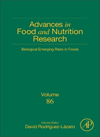Antimicrobial Resistance in the Food Chain in the European Union
The book Biological Emerging Risks in Foods edited by Academic Press includes this chapter
August 3rd, 2018
Florez-Cuadrado D., Moreno MA., Ugarte-Ruiz M. and Dominguez L..
Consumers require safety foods but without losing enough supply and low prices. Food concerns about antimicrobial residues and antimicrobial-resistant (AMR) bacteria are not usually appropriately separated and could be perceived as the same problem. The monitoring of residues of antimicrobials in animal food is well established at different levels (farm, slaughterhouse, and industry), and it is preceded by the legislation of veterinary medicines where maximum residues limits are required for medicines to be used in food animal. Following the strategy of the World Health Organization, one of the proposed measures consists in controlling the use of critical antibiotics. The European Union surveillance program currently includes the animal species with the highest meat production (pigs, chickens, turkeys, and cattle) and the food derived from them, investigating antimicrobial resistance of zoonotic (Salmonella and Campylobacter) and indicator (Escherichia coli and enterococci) bacteria. AMR mechanisms encoded by genes have a greater impact on transfer than mutations. Sometimes these genes are found in mobile genetic elements such as plasmids, transposons, or integrons, capable of passing from one bacterium to another by horizontal transfer. It is important to know that depending on how the resistance mechanism is transferred, the power of dissemination is different. By vertical transfer of the resistance gene, whatever its origin, will be transmitted to the following generations. In the case of horizontal transfer, the resistance gene moves to neighboring bacteria and therefore the range of resistance can be much greater
 | Servicio de Zoonosis de Transmisión Alimentaria y Resistencia a Antimicrobianos (ZTA). Centro de Vigilancia Sanitaria Veterinaria (VISAVET). Universidad Complutense (UCM). 111 |
 | Departamento de Sanidad Animal. Facultad de Veterinaria. Universidad Complutense (UCM). 111 |

